
Introduction
Nestled in the Nishikyo Ward of Kyoto City, Saiho-ji Temple is a beautiful sanctuary famed throughout the world as “Koke-dera,” the Moss Temple. Its garden, blanketed with over 120 varieties of moss, creates a fantastical landscape resembling a lush, green velvet carpet that captivates all who visit. In this article, we will delve into its history, highlight its most captivating features, and explain how to visit.
はじめに
京都市西京区に佇む西芳寺(さいほうじ)は、通称「苔寺(こけでら)」として世界的に知られる美しい寺院です。120種類以上もの苔に覆われた庭園は、まるで緑のビロードを敷き詰めたかのような幻想的な光景を創り出し、訪れる人々を魅了します。今回は、その歴史と見どころ、そして参拝方法について詳しくご紹介します。
The History of Saiho-ji Temple
The history of Saiho-ji is long, beginning in the 700s during the Nara period when it was founded by the Buddhist monk Gyoki as “Saiho-ji” (西方寺), a temple of the Hosso school. It was later converted to the Jodo (Pure Land) school by the priest Honen in the Kamakura period.
In 1339, at the invitation of a high-ranking official of the Muromachi shogunate, the renowned garden master Muso Soseki arrived. He changed the temple’s name to “Saiho-ji” (西芳寺) and established it as a Rinzai Zen temple. Muso Soseki developed the grounds and created the prototype for the garden we see today. Its stunning design had a profound influence on later generations, reportedly serving as the model for the Golden Pavilion (Kinkaku-ji) built by Ashikaga Yoshimitsu and the Silver Pavilion (Ginkaku-ji) by Ashikaga Yoshimasa.
However, the magnificent buildings were lost to the fires of war, including the Onin War, and the garden fell into ruin due to repeated flooding. Over long years of neglect, moss gradually overtook the garden, giving birth to the sublime “Moss Garden” of today.
西芳寺の歴史
西芳寺の歴史は古く、奈良時代の700年代に行基菩薩によって開かれた法相宗の「西方寺」が始まりとされています。その後、鎌倉時代に法然上人によって浄土宗に改宗されました。
1339年、室町幕府の重臣であった藤原氏の招きにより、作庭の名手として名高い夢窓国師が入山し、寺の名前を「西芳寺」と改めて臨済宗の寺院としました。夢窓国師はこの地を整備し、現在の庭園の原型を築き上げました。その美しい庭園は、後の時代にも大きな影響を与え、足利義満が金閣(鹿苑寺)を、足利義政が銀閣(慈照寺)を建てる際に、この西芳寺の庭園を模範にしたと言われています。
しかし、応仁の乱などの戦火や度重なる洪水により、壮麗を極めた建物は失われ、庭園は荒廃してしまいます。長い年月を経て、人の手が離れた庭園を苔が覆い尽くし、現在の幽玄な「苔の庭」が生まれたのです。
Highlights of Saiho-ji Temple
A Calming Sutra-Copying Experience
A visit to Saiho-ji begins with shakyo, or sutra copying, in the main hall. By calming your mind and carefully copying each character, you can step away from the hustle and bustle of daily life and spend precious time reflecting inwardly.
The Moss Garden: “Kojo-kan” and the “Ogon-chi” Pond
After copying sutras, it is time to stroll through the garden. The garden is composed of two levels. The lower level is a circuit-style garden centered around the “Ogon-chi” (Golden Pond). The sight of islets such as Asahi-jima, Yuhi-jima, and Kiri-shima floating in the pond, surrounded by a carpet of over 120 moss varieties, is simply breathtaking.
The upper level features a kare-sansui (dry landscape garden) called “Kojo-kan,” which expresses the world of Zen through stone arrangements. This tranquil space is said to be where the master Muso Soseki once practiced meditation.
西芳寺の見どころ
心静まる「写経」体験
西芳寺の参拝は、まず本堂での写経から始まります。心を落ち着けて一文字一文字丁寧に写経をすることで、日常の喧騒から離れ、自分自身と向き合う貴重な時間を過ごすことができます。
苔の庭園「向上関」と「黄金池」
写経を終えた後はいよいよ庭園の散策です。庭園は上下二段で構成されており、下段は「黄金池(おうごんち)」を中心とした池泉回遊式庭園です。池には朝日島、夕日島、霧島といった小島が浮かび、その周りを120種類以上もの苔が覆い尽くす光景は圧巻です。
上段は「向上関(こうじょうかん)」と呼ばれる枯山水庭園で、石組みによって禅の世界が表現されています。静寂に包まれたこの場所は、かつて夢窓国師が修行した場所とも言われています。
How to Visit
To provide a serene environment and a quiet time for its visitors, admission to Saiho-ji is by reservation only. Please be aware that you cannot visit without a prior booking.
- How to Apply: Reservations must be made in advance through the official portal site of the “Saiho-ji Temple General Incorporated Association.”
- Types of Visits:
- Daily Visit: The standard plan, which includes the sutra copying session and a tour of the garden.
- Special Visit: Limited-capacity special programs such as morning Zazen meditation sessions and seasonal viewings are also occasionally available.
参拝方法について
西芳寺は、静かな環境で参拝者に心静かな時間を提供するため、事前申込制となっています。ふらりと立ち寄って拝観することはできませんのでご注意ください。
- 申込方法: 参拝は、公式ポータルサイト「一般社団法人西芳会」からの事前申し込みが必要です。
- 参拝の種類:
- 日々参拝: 西芳寺の基本的な参拝プランで、写経と庭園の見学が含まれます。
- 折々参拝: 朝の坐禅会や季節限定の特別拝観など、より深く西芳寺を体験できるプログラムも用意されています。(不定期開催)
The Main Hall (Sairaido Hall) 【本堂(西来堂)】
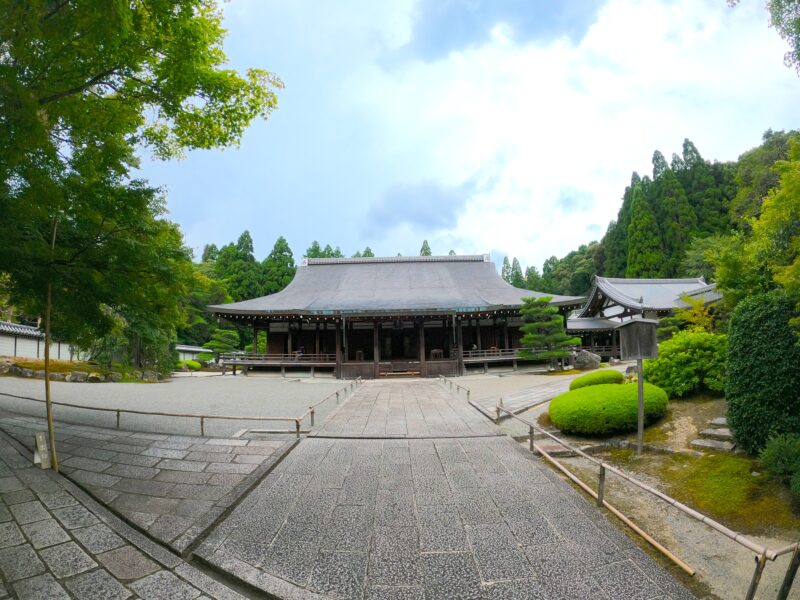
The Main Hall, Wrapped in Tranquility
This is the main hall of Saiho-ji Temple, also known as the Seshido. This is where visitors first quiet their minds by copying sutras. The stately building, with its beautiful roof and sturdy pillars, exudes a powerful beauty characteristic of a Zen temple. In the white gravel garden in front, a weeping willow adds a touch of grace, while a large stone monument testifies to the temple’s long history.
心静まる、西芳寺の本堂
こちらは西芳寺の中心となる建物、本堂(西来堂)です。参拝者が写経を行うのもこの場所で、庭園散策の前に、まずここで心を落ち着けることになります。その堂々とした姿は、禅寺らしい簡素で力強い美しさを感じさせます。白砂の庭のしだれ柳や、文字が刻まれた大きな石碑も、この寺の長い歴史を物語っています。
Temple Entrance Gate (Sho Myo Mon) 【衆妙門】
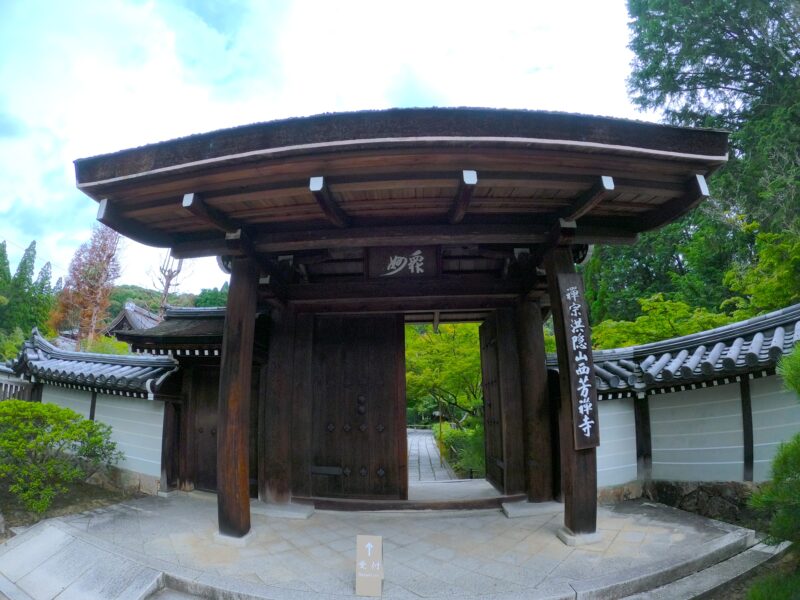
Shumyomon: The Gate to the Sacred Realm
Also known as Shumyomon, this dignified wooden gate serves as a spiritual threshold. It solemnly welcomes visitors from the everyday world into the sacred garden beyond, acting as a symbolic boundary between the secular and the divine.
聖域への入り口「衆妙門(しゅうみょうもん)」
衆妙門(しゅうみょうもん)とも呼ばれる、風格のある木造の門です。この門は、訪れる人々を日常の世界から、その先に広がる神聖な庭園へと厳かに迎え入れる結界の役割を果たしています。
Historic Monuments of Ancient Kyoto【世界遺産「古都京都の文化財】
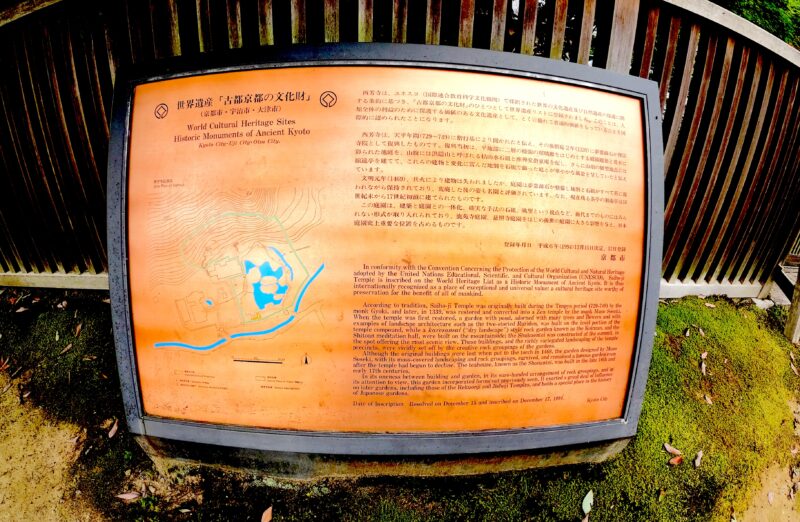
A Testament to a World Cultural Heritage Site
This sign, installed within the temple grounds, officially designates the Saiho-ji Temple Garden as a UNESCO World Cultural Heritage Site. It details in both Japanese and English the temple’s significant cultural value, including its influence on later gardens like Kinkaku-ji and Ginkaku-ji.
世界遺産「古都京都の文化財」の証
境内に設置されているこの案内板は、西芳寺庭園がユネスコの世界文化遺産であることを公式に示しています。案内板には、その卓越した作庭技術が後の金閣寺や銀閣寺の庭園にも影響を与えたことなど、寺院の重要な文化的価値が日本語と英語で詳述されています。
Path of Stepping Stones 【飛び石の小径】
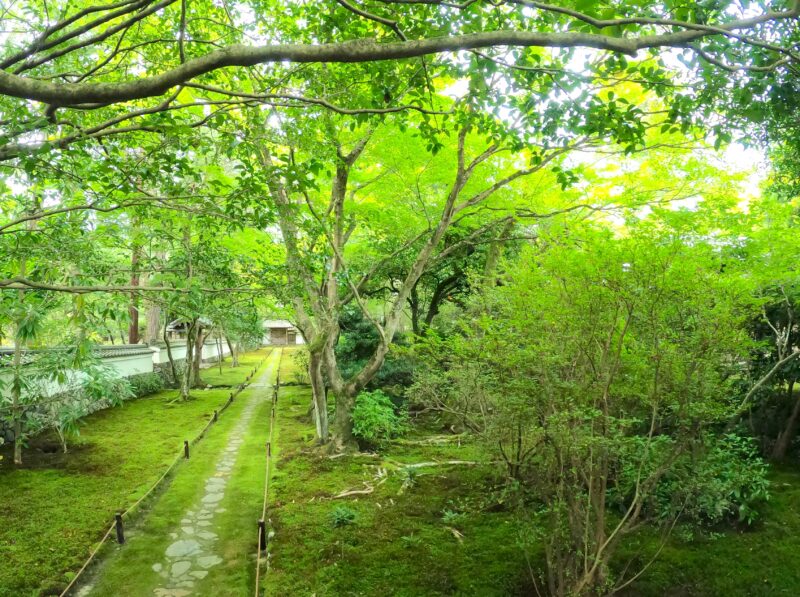
A Path Through a Carpet of Green
This is a scene that truly symbolizes Saiho-ji, earning it the name “Moss Temple.” A stone path meanders through a garden landscape completely covered in a vibrant carpet of moss. The contrast between the verdant moss and the white earthen wall running alongside it enhances the beauty of this otherworldly view.
緑の絨毯を進む、幻想的な小径
これぞ「苔寺」という言葉がふさわしい、西芳寺を象徴する風景です。一面が緑の苔に覆われた庭の中を、飛び石の小径が奥へと続いています。隣に続く白い土塀と苔の緑との対比が、この世のものとは思えないほどの眺めを創り出しています。
Kojo-Kan【向上関】
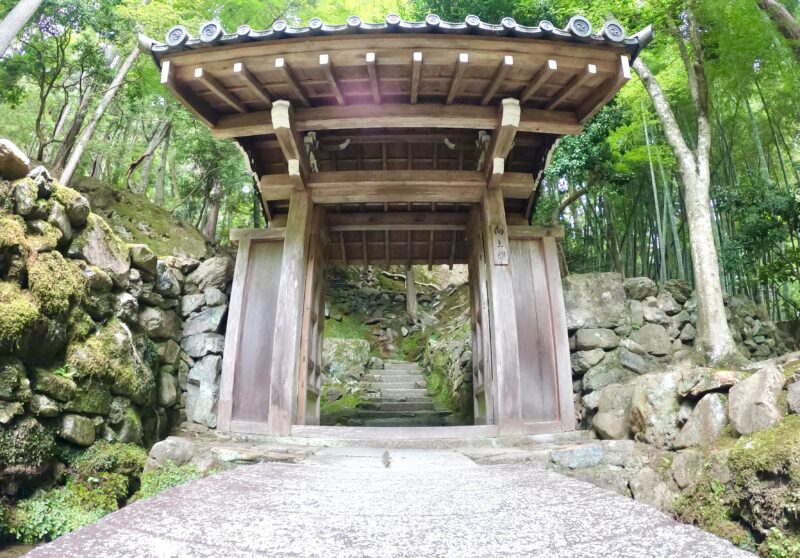
The “Kojo-kan” Gate, Leading to the Upper Garden
Nestled between moss-covered stone walls, this charming wooden gate is known as the “Kojo-kan.” It serves as the entrance from the lower pond garden to the upper rock garden. The stone steps leading upward through the gate invite visitors to a quieter, more spiritual space.
山の庭へと誘う「向上関」
苔むした石垣の間にある風情豊かなこの門は「向上関(こうじょうかん)」と呼ばれ、下の池泉回遊式庭園から、上の枯山水庭園へと続く入口です。門の向こうに続く石段は、より静かで精神性の高い空間へと参拝者を誘います。
Shonan-tei 【湘南亭】
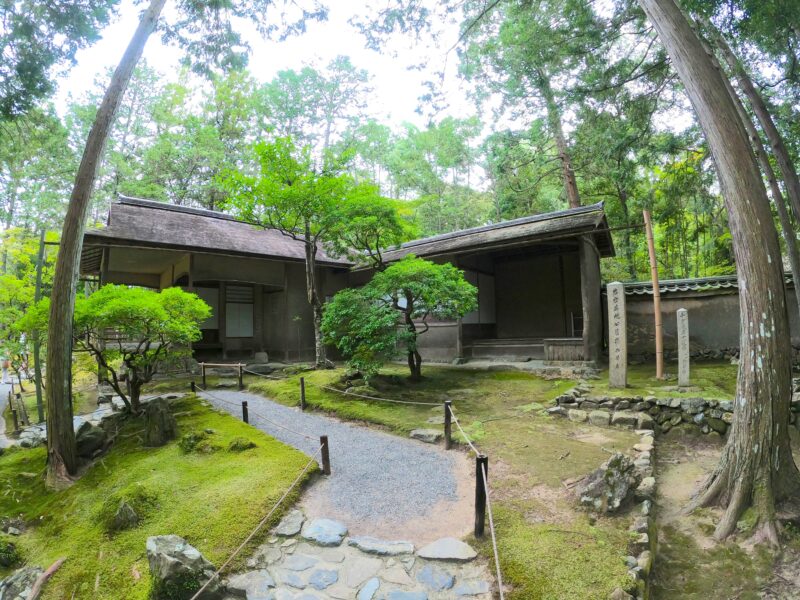
The “Shonan-tei” Teahouse, Resting in the Moss Garden
Resting quietly within the moss garden is the “Shonan-tei,” a historic teahouse designated as an Important Cultural Property. Its rustic design, featuring a thatched roof and earthen walls, embodies the Japanese aesthetic of “wabi-sabi” and blends seamlessly into the surrounding nature.
苔庭に佇む茶室「湘南亭」
苔の絨毯の中に静かに佇むこの建物は、重要文化財に指定されている茶室「湘南亭(しょうなんてい)」です。茅葺きの屋根や土壁など、質素で自然な素材を活かしたその造りは、「わびさび」の精神を色濃く反映し、周囲の自然と見事に一体化しています。
Teahouse 【茶屋】
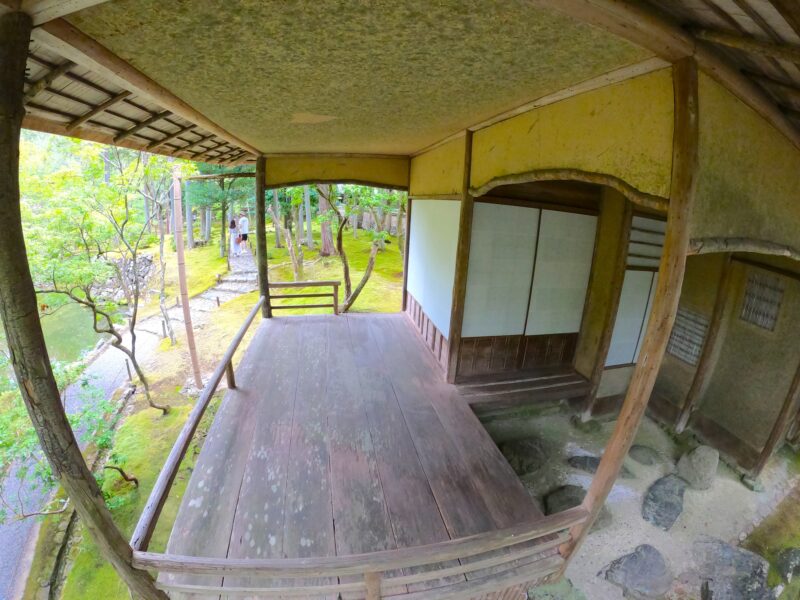
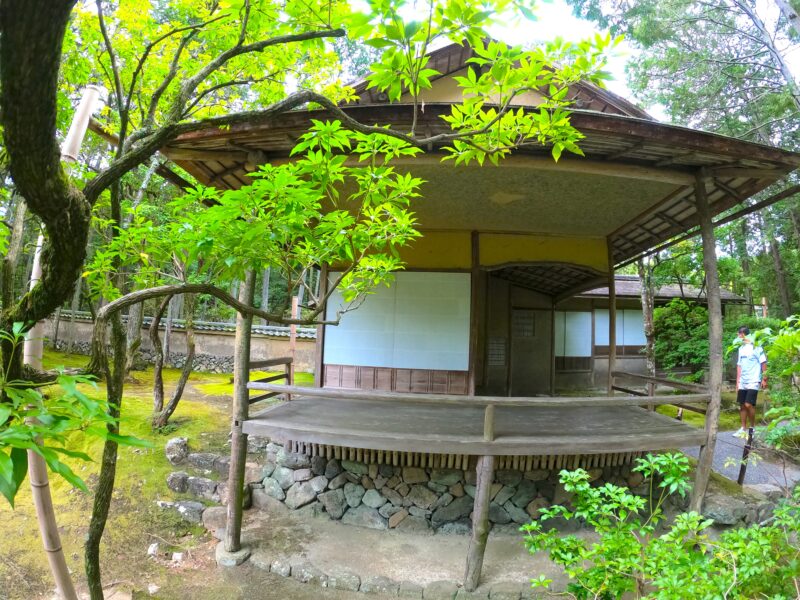
A Picturesque View from the “Shonan-tei” Teahouse
This is the view from the veranda of the “Shonan-tei” teahouse. The pillars and walls of the structure act as a natural frame, presenting the vivid garden as a living masterpiece of art. This spot was designed for sitting quietly to savor the scenery, offering a special seat to fully experience the beauty of Saiho-ji.
茶室「湘南亭」から眺める絶景
重要文化財の茶室「湘南亭」の縁側からの眺めです。柱や壁が額縁となり、生き生きとした庭の姿が一枚の絵画のように目に飛び込んできます。ここは静かに座って景色を味わうために作られた場所であり、西芳寺の魅力を五感で感じるための特等席です。
Kannon Bodhisattva Hall【観音堂】
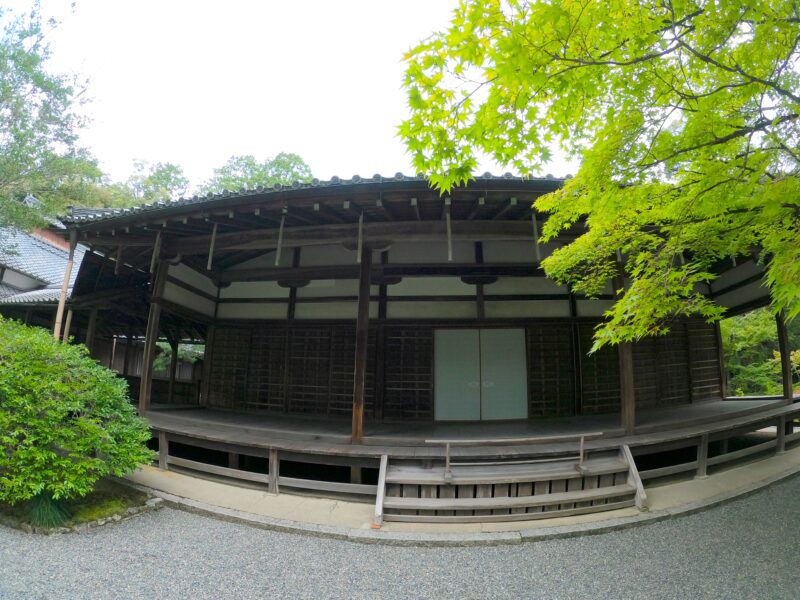
Of course, here is the English translation of the article about the Kannon-do Hall at Saiho-ji Temple.
The Kannon-dō Hall at Saihō-ji Temple: A Sacred Sanctuary of Serenity for the Holy Kannon Bodhisattva
Quietly nestled within the grounds of Saihō-ji Temple, the Kannon-dō Hall is a sacred place enshrining a standing statue of the Shō Kannon Bodhisattva.
This hall served as the main temple building until the Sairai-dō Hall was rebuilt during the Showa era. Understanding this historical background allows one to feel the deep meaning and value that the Kannon-dō holds even more profoundly.
Here, visitors can spend a moment in quiet prayer and feel the compassion of the Holy Kannon Bodhisattva. When you visit Saihō-ji Temple, be sure to also stop by the Kannon-dō Hall to experience its history and serene atmosphere.
西芳寺の観音堂:静寂に佇む聖観音菩薩の聖域
西芳寺の境内に静かに佇む観音堂は、聖観音菩薩立像を祀る神聖な場所です。
このお堂は、昭和の時代に西来堂が再建されるまで、本堂として中心的な役割を担っていました。その歴史的背景を知ることで、観音堂の持つ深い意味と価値をより一層感じることができるでしょう。
訪れる人々は、ここで静かな祈りの時を過ごし、聖観音菩薩の慈悲に触れることができます。西芳寺を訪れた際には、ぜひ観音堂にも足を運び、その歴史と静寂な雰囲気を味わってみてください。
【画像:GOPR4680.jpg】
Sacred Tree (Shinboku) – A tree revered as the dwelling place of a deity in the Shinto tradition.【御神木】
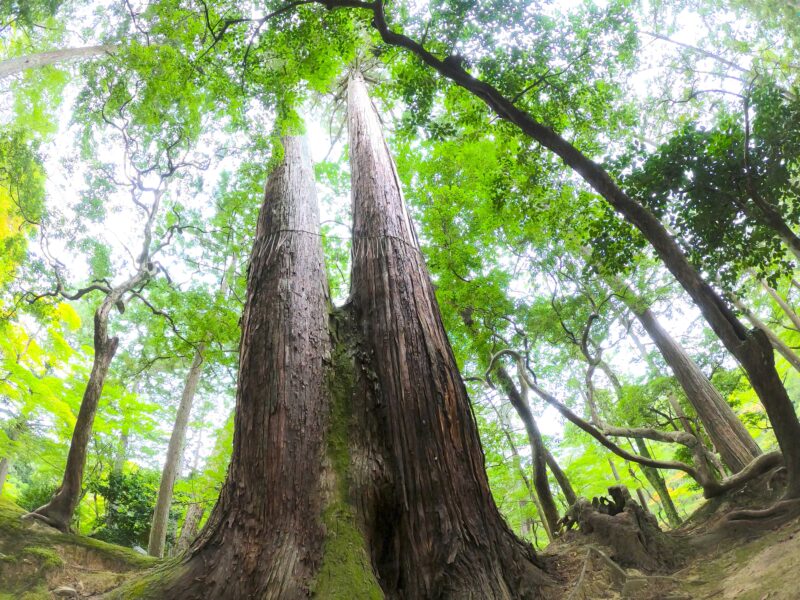
Twin Giants Reaching for the Heavens
Standing side-by-side from their base, these two colossal cedar trees are a striking sight in the forest. Their overwhelming height and massive trunks evoke a powerful sense of nature’s grandeur and vitality. Moss clings to their bark, a testament to the long years they have stood watch over the Saiho-ji garden, like divine guardians of the grounds.
天を突くように立つ、二本の巨木
森の中でひときわ目を引く、天に向かってまっすぐに伸びる二本の巨大な杉の木。根元から寄り添うようにして立つその姿は、圧倒的な高さと、どっしりとした幹の太さに、自然の雄大さと生命力の強さを感じさせます。幹にはびっしりと苔が生え、西芳寺の庭園を見守り続ける守り神のような存在です。
Nature’s green carpet woven with moss【苔の絨毯】
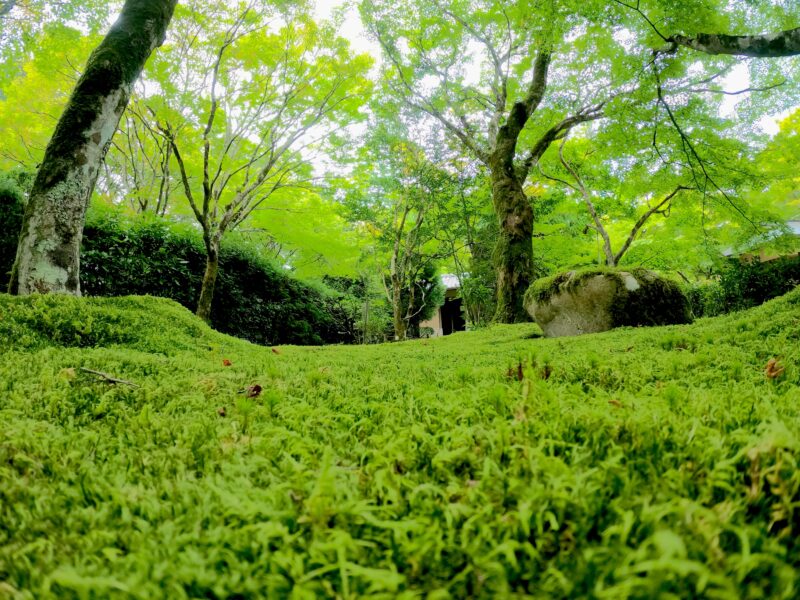
A Breathtaking Carpet of Moss
This photo, taken from a low angle close to the ground, makes you feel as if you have shrunk and wandered into a forest of moss. You can see each individual moss plant standing vibrantly, glistening in the light. This image reveals that what we usually call “moss” is actually a diverse community of life, drawing you into the beauty and vitality of the garden’s microcosm.
息をのむほど美しい、苔の絨毯
地面に広がる苔に、ぐっと近づいて撮影された一枚です。まるで自分が小人になって、苔の森に迷い込んだかのような不思議な感覚を覚えます。一本一本の苔が生き生きと立ち上がり、光を浴びて輝く様子が詳細に見て取れます。普段私たちが「苔」として一括りにしているものが、実は多様な生命の集合体であることに気付かされる、庭園のミクロの世界の美しさに見入ってしまう一枚です。


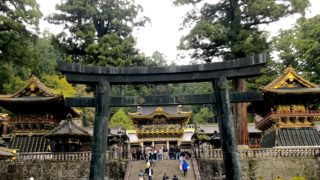
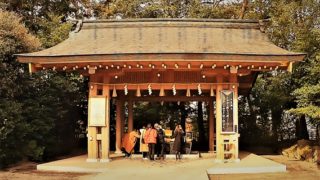
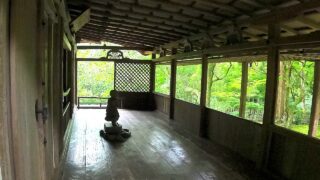

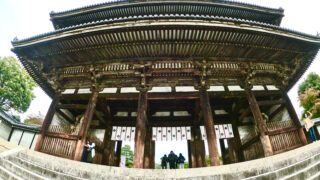
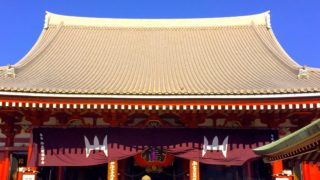



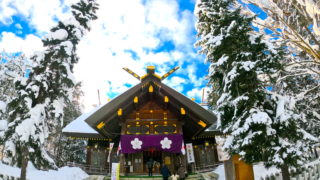

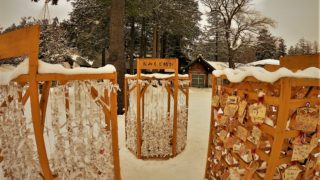
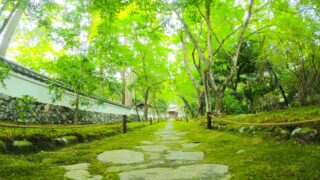


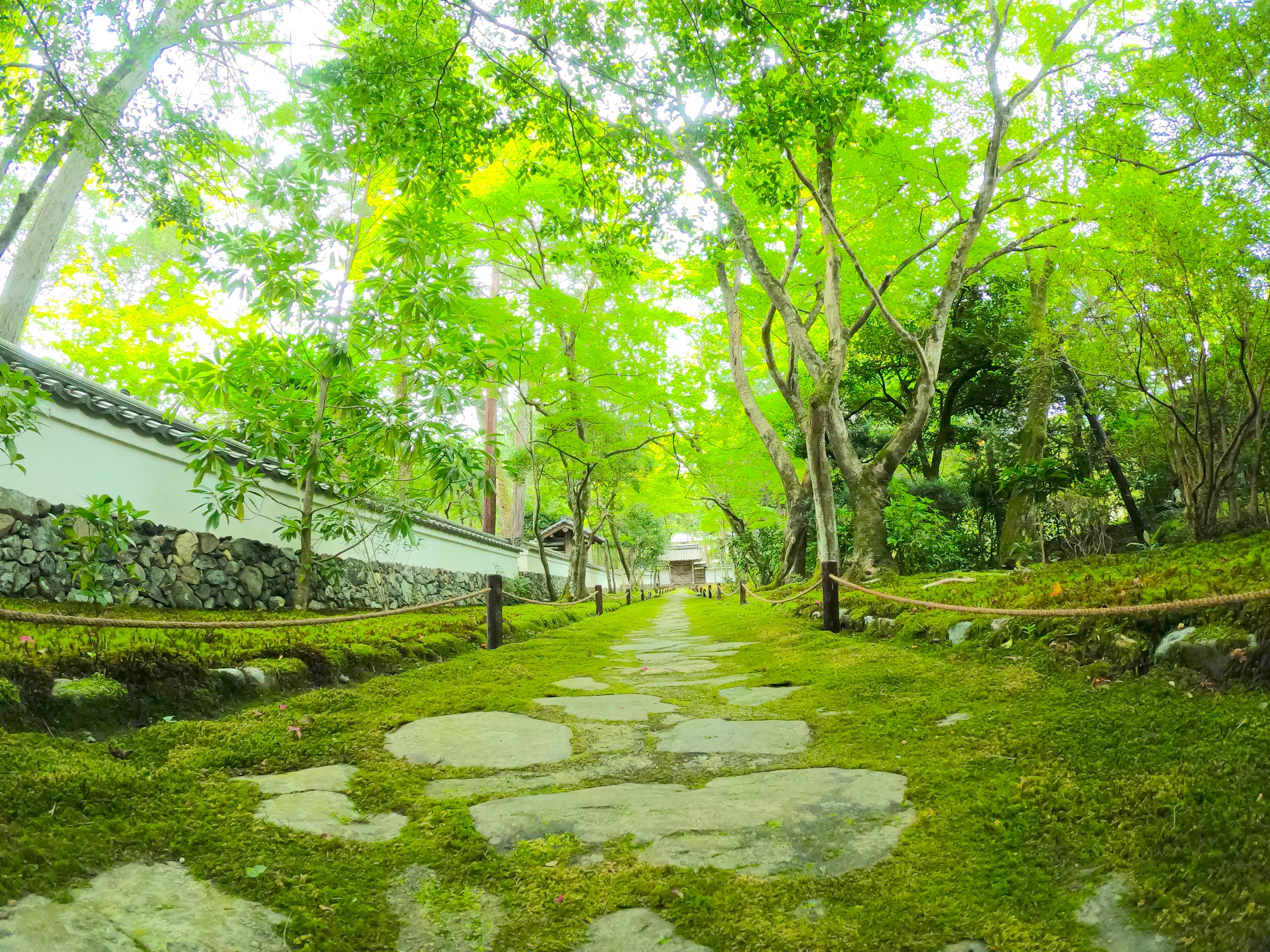



コメント